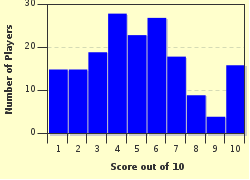Quiz Answer Key and Fun Facts
1. The instruments in a modern orchestra are divided up into sections - for instance the violins and cellos are part of the "string" section. How many sections are there in total?
2. Occasionally a piano is added to the orchestra. In which section would it be placed?
3. Which of the following is not a valid member of the percussion section?
4. During the Baroque period (up to around the time of J.S. Bach), how would an orchestra normally be controlled?
5. Over the centuries, not only has the orchestra grown in size, but also the number of different instruments used in an orchestra has increased. When was the trombone first used for a symphony?
6. In 1946 a young British composer wrote a piece of music called "A Young Person's Guide to the Orchestra" which introduced the various instruments of the orchestra. Who was the composer?
7. Which orchestra claims to be the world's oldest?
8. From what language is the word "orchestra" derived, and what does it mean?
9. Referring to the normal layout of a modern symphony orchestra: which group of players sits immediately in front of the conductor?
10. On 15th May 2000 the world's largest orchestra (at that time) was assembled in B.C. Place, Vancouver. How many instrumentalists joined the Vancouver Symphony orchestra for the event?
Source: Author
cliveh
This quiz was reviewed by FunTrivia editor
ertrum before going online.
Any errors found in FunTrivia content are routinely corrected through our feedback system.

